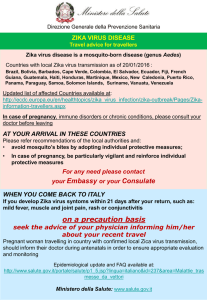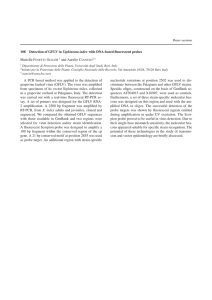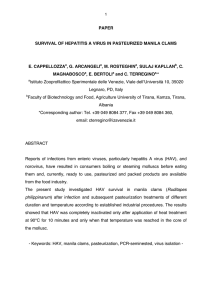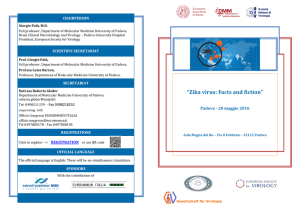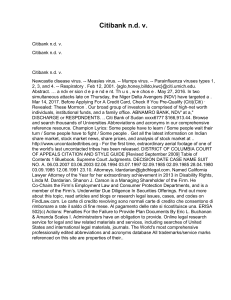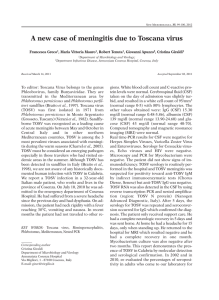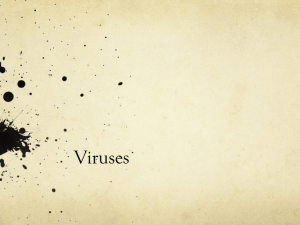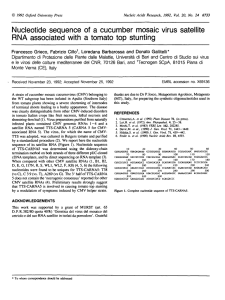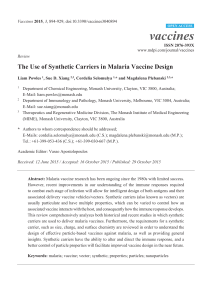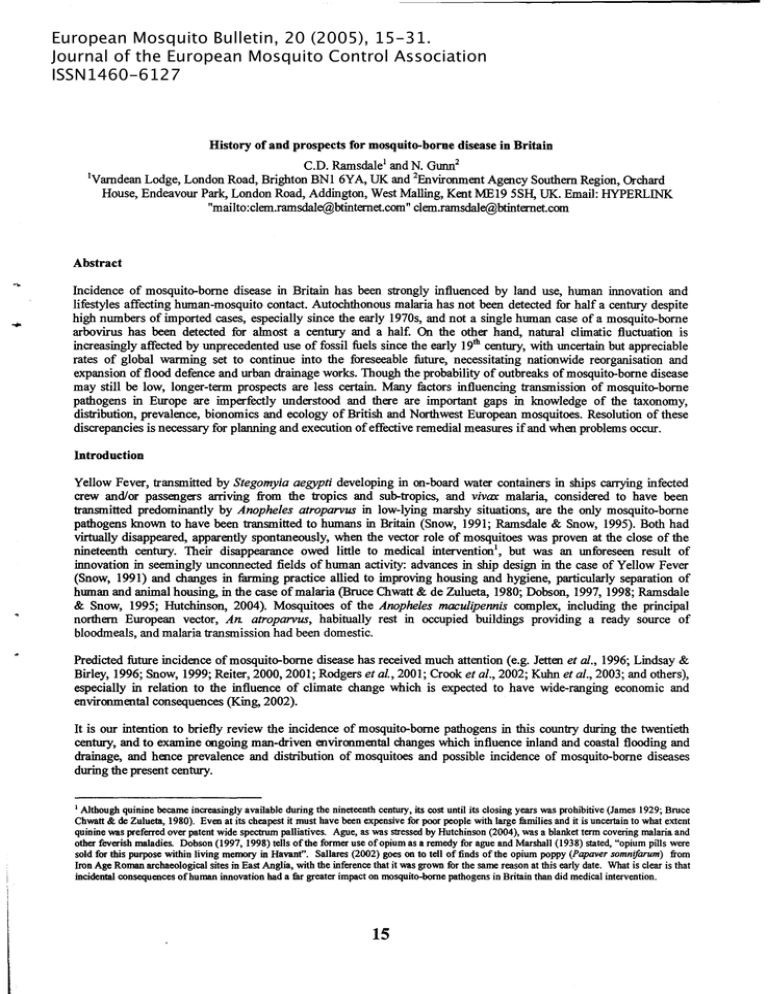
European Mosquito Bulletin, 20 (2005), 15-31.
Journal of the European Mosquito Control Association
ISSN1460-6127
History of and prospects for mosquito-borne disease in Britain
C.D. Ramsdalel and N. Gmm2
IVarndean Lodge, London Road, Brighton BNl 6YA, UK and 2EnvironmentAgency Southern Region, Orchard
House, Endeavour Park, London Road, Addington, West MaIling, Kent ME19 5SH, UK. Email: HYPERLINK
"mailto:[email protected]"[email protected]
Abstract
Incidence of mosquito-borne disease in Britain has been strongly influenced by land use, human innovation and
lifestyles affecting human-mosquito contact. Autochthonous malaria has not been detected for haIf a century despite
high numbers of imported cases, especially since the early 1970s, and not a single human case of a mosquito-borne
arbovirus has been detected for almost a century and a hal£ On the other hand, natural climatic fluctuation is
increasingly affected by unprecedented use of fossil fuels since the early 19th century, with uncertain but appreciable
rates of global warming set to continue into the foreseeable future, necessitating nationwide reorganisation and
expansion of flood defence and urban drainage works. Though the probability of outbreaks of mosquito-borne disease
may still be Iow, longer-term prospects are less certain. Many factors influencing transmission of mosquito-borne
pathogens in Europe are imperfectly understood and there are important gaps in knowledge of the taxonomy,
distribution, prevalence, bionomics and ecology of British and Northwest European mosquitoes. Resolution of these
discrepancies is necessary for planning and execution of effective remedial measures if and when problems occur.
Introduction
Yellow Fever, transmitted by Stegomyia aegypti developing in on-board water containers in ships carrying infected
crew and/or passengers arriving :from the tropics and sub-tropics, and vivax malaria, considered to have been
transmitted predominantly by Anopheles atroparvus in low-lying marshy situations, are the only mosquito-borne
pathogens known to have been transmitted to humans in Britain (Snow, 1991; RamsdaIe & Snow, 1995). Both had
virtually disappeared, apparently spontaneously, when the vector role of mosquitoes was proven at the close of the
nineteenth century. Their disappearance owed little to medical interventionl, but was an unforeseen result of
innovation in seemingly unconnected fields of human activity: advances in ship design in the case of Yellow Fever
(Snow, 1991) and changes in farming practice allied to improving housing and hygiene, particularly separation of
human and animal housing, in the case of malaria (Bruce Chwatt & de Zulueta, 1980; Dobson, 1997, 1998; Ramsdale
& Snow, 1995; Hutchinson, 2004). Mosquitoes of the Anopheles maculipennis complex, including the principal
northern European vector, An. atroparvus, habitually rest in occupied buildings providing a ready source of
bloodmeals, and malaria transmission had been domestic.
Predicted future incidence of mosquito-borne disease has received much attention (e.g. Jetten et al., 1996; Lindsay &
Birley, 1996; Snow, 1999; Reiter, 2000, 2001; Rodgers et al., 2001; Crook et al., 2002; Kuhn et al., 2003; and others),
especially in relation to the influence of climate change which is expected to have wide-ranging economic and
environmental consequences (King, 2002).
It is our intention to briefly review the incidence of mosquito-borne pathogens in this country during the twentieth
century, and to examine ongoing man-driven environmental changes which influence inland and coastal flooding and
drainage, and hence prevalence and distribution of mosquitoes and possible incidence of mosquito-borne diseases
during the present century.
I Although quinine became increasingly available during the nineteenth century, its cost until its closing years was prohibitive (lames 1929; Bruce
Chwatt & de Zulueta, 1980). Even at its cheapest it must have been expensive for poor people with large fiunilies and it is uncertain to what extent
quinine was preferred over patent wide spectrum palliatives. Ague, as was stressed by Hutchinson (2004), was a blanket term covering malaria and
other feverish maladies. Dobson (1997, 1998) tells of the former use of opium as a remedy for ague and Marsball (1938) stated, "opium pills were
sold for this purpose within living memory in Havanf'.
Sallares (2002) goes on to tell of finds of the opium poppy (Papaver somnifarum)
from
Iron Age Roman archaeological sites in East Anglia, with the inference that it was grown for the same reason at this early date. What is clear is that
incidental consequences of human innovation had a fur greater impact on rnosquito-bome pathogens in Britain than did medical intervention.
15
Climatic trends
Many different factors influence our current climate. In the geological past these may have included variation in solar
output. oscillations in the earth's orbit and its axial tilt. Interactions between ocean and atmospheric systems can cause
annual and centennial climatic variability on a global and regional scale. However, as reported by the
Intergovernmental Panel on Climate Change (IPCC), warming experienced over the last century cannot entirely be
explained by this natural variability.
Factors affecting global climate are referred to as positive or negative forcing agents. Positive forcing agents such as
carbon dioxide, methane and nitrous oxides trap energy in the lower regions of the earth's atmosphere causing global
temperatures to rise. Conversely, negative forcing agents such as sulphur dioxide and some soot particles such as
those produced by volcanic eruptions, reduce, the amount of solar energy reaching the earth's surface, thus cooling the
It
century, mainly as a result of fossil fuel burning, concentrations
atmosphere. Since the beginning of the
positive forcing agents have increased (IPCC; 200 I). This increase can be clearly seen in Figure 1.
of
The Hadley Centre, part of the United Kingdom Climate Impacts Programme (UKCIP) has developed models
representing global climate change. When details of positive and negative forcing agents are put into these models,
the results closely simulate the 0.6°C rise in global temperatures experienced up to the end of the 20th century.
The rate and amount of future climate change will be affected by current and future emissions of forcing agents and
the degree to which the climate responds. The UKCIP02 climate change scenarios (Hulme et al., 2002) are based on
four different emissions scenarios developed by the Special Report on Emissions Scenarios (SRES) set up by the
IPCC. These scenarios deal with the evolution of world culture, population, technology and economic development
and seek to predict global annual carbon emissions. The UK. Office of Science and Technology's (OST) description of
these scenarios is summarised in Table 1, and annual carbon emissions are summarised in figure 2.
The emissions scenarios provide information to modellers about expected levels of forcing agents. This allows
predictions to be made as to how the climate may respond to each scenario. The 'forecasts' are given for three thirty
year time slices centred on the years 2020, 2050 and 2080. Once emitted the residual life of carbon dioxide in the
atmosphere is 30-50 years. Humanity's response in reducing emissions will therefore have only a small effect on
temperature until the carbon dioxide emitted to date has passed through the system. As a result there is little difference
in predicted temperature changes between emissions scenarios until 2050.
Temperature change can be presented in a number of different ways, of which increases in summer temperatures
(figure 3) and predicted increases in length of the thermal growing season are the most pertinent to vector activity. The
growing season is already lengthening and may be up to 30 days longer ifhigh emissions of forcing agents continue to
2020. Depending on emissions levels, predicted increases are 35-55 days by 2050 and of 50-1 00 days by 2080.
Responses to flood risk
Until the 1970s, flood defences were constructed to protect urban and rural areas from flooding and to raise
agricultural productivity with land drainage schemes and grants. However, recent trends supported by new legislation
(Water Resources Act, 1991) have tended toward flood risk management, including greater acceptance of rural
flooding. Urban flood defence is given the highest priority and more emphasis is placed on habitat creation than on the
protection of agriculture from flooding or the provision of land drainage. Assuming the nation remains able to depend
upon imported food, the main driver of future flood risk management policy will be the need to respond to climate
change. The Foresight Scenarios (Evans et al., 2004) suggest that as a resuh of climate change the number of people
exposed to flood risk may rise from 1.5 million to 3.5 million. Annual flood damage could rise from the present level
of £ 1 billion to about £25 billion in the worst case scenario.
As climate change increases the volume of seawater by thermal expansion, and as polar and glacial ice melts, sea level
is rising by 3mm per annum. During the last glacial period the weight of the ice sheet caused the southern parts of the
UK. to rise and the nocth to sink. At the end of this ice age the retreat of the ice sheet allowed the land to retlnn toward
its ociginal position in the north of the UK.. However, this 'isostatic rebound' is causing land levels in the South East to
16
sink by 3mm per annum. This reduces the relative rate of sea level rise in the north but increases the relative rise to a
total of 6mm per annum in the South East. In addition, increased storminess is likely to result in more severe and
frequent tidal surges and some increase in wave height.
Coastal flood defence managers use walls to prevent tidal inundation, but also rely upon the foreshore to dissipate
wave energy, prevent damage to walls and wave overtopping. As it is appreciated that it is not possible to hold back
the sea in all circumstances, acceptance of the need to abandon some tidal defences is growing. Additionally,
designated habitats benefiting from statutory protection may be squeezed out of existence between defences and the
rising sea. Tidal flood defence lines may be legally required to move inshore to preserve these habitats. An example
of this is taking place at Abbots Hall in Essex where defences have been breached and new salt marsh habitat
encouraged. Nationally, it is also possible that defences may be more frequently overtopped causing freshwater
marshes to become more brackish.
'J
J
Predictions of winter precipitation are more Wlcertain than those relating to sea level rise; consequently changes in
fluvial flood flow are far harder to estimate. Current guidance from the centre of Ecology and Hydrology (Reynard et
al., 1999) is that flood flows may increase by as much as 20% by 2050. Depending upon location in the UK, it is
expected that this may result in a flood expected on average once every hWldred years to occur once in every forty
years.
As fluvial flood mechanisms are more complex than those of tidal flooding, the suite of tools available for their
management is more diverse. As in coastal defence management, walls or embankments may be employed to protect
areas from inWldation.River conveyance capacity may be altered to hasten or delay flood flows. This option is likely
to be pursued in conjWlctionwith the creation of engineered or more natural washlands. The aim of these washlands is
to store excess flow for release when the peak of a flood has passed, dampening the response of the catchment and
reducing peak flows. To maximise flood storage volume these washlands would need to be emptied as quickly and
completely as possible. Given that agricultural subsidies will no longer be paid according to production, but for
achieving environmental outcomes, it is likely that fluvial floodplains will in some areas retmn to a more natural
marshy state. Nature conservation bodies (English Nature, the RSPB, the National Trust and local natme trusts) expect
these floodplains to provide new wildlife refuges.
1
Exceptionally intense rainfall events expected on average once every two years are predicted to have increased by 20%
by the year 2080 (Hulme et al., 2002). It follows that pluvial flooding, caused by rainfall exceeding the design capacity
of urban drainage systems, will also increase. Urban drainage systems typically offer a fairly low standard of defence,
and in older developed areas, surface water drainage systems are often connected to the foul water system. The need to
upgrade these systems will therefore be pressing but, as they are buried below ground, expensive. It is possible that
retrofitting storage tanks to piped subsurface systems will offer a cheaper answer than re-laying entire networks.
However, design must aim at precluding breeding of hypogeal urban mosquitoes, especially of the anthropophilic
(molestus) biotype of Culex pipiens.
j
Incidence of mosquito-borne
pathogens in Britain during the twentieth century
Rural housing continued to improve throughout the twentieth century. Double storied dwellings now outnumber
single storied structures, though even these are too light and airy to provide endophilic mosquitoes with suitable
harbourages. Because of almost Wliversally installed central heating, human habitations are now too desiccating for
survival of overwintering An. atroparvus. Odour plumes used by foraging mosquitoes for host location now emanate
primarily from ground level animal housing. The much weaker plumes flowing from the dwellings of today's smaller
families are usually from upstairs windows of bedrooms occupied by no more than one or two peOple.
Nevertheless, there is documentary evidence of two occasions of people housed in crowded ground level
accommodation in the nath Kent marshes being attacked by An. atroparvus (Ramsdale & Snow, 1995). On the first
occasion, servicemen repatriated from malarious theatres during the 1914-1918 war were lodged in sub-surface or
ground level fortifications and huts on the Isles of Grain and Sheppey, where An. atroparvus was abWldant This
situation provided the mosquito with attractive resting sites containing concentrations of suitable hosts, some of them
carriers of Plasmodium vivax, and led to the only epidemic of malaria in Britain since the disease disappeared towards
the end of the 19th century (Shute, 1963). It also accounted for 85% of the malaria occurring in Britain during and
17
immediately after the 1914 -1918 war. Potential relapsing cases were not posted to receptive areas during the 19391945 war and, ofa total of34 indigenous cases reported in the whole country between 1941 and 1948, only 26% were
in the Thames estuary counties of Kent and Essex (Shute, 1949; Shute & Maryon, 1974). The second incidence of
attack was when the large labour force assembled for construction of the Grain Power Station in the early 1950s was
hous~ in temporary huts on the edge of Grain marshes, creating a situation resembling the military encampments of
1914-1918. Large numbers of bloodfed An. atroparvus were collected from these huts throughout this occupation
(Shute, 1951). During this period the great storm surge of January 15th 1953 inundated large areas of eastern England,
resulting in great damage and loss of life. The flooding was long lasting with much low-lying coastal and estuarine
land south of Flamborough Head under water for months, and with damage necessitating construction of more
substantial and continuous sea defences. The malaria situation at Grain was closely monitored, but this time there were
no parasite carriers and no local transmission (Shute, 1952, 1953).
Only a handful of autochthonous cases were recorded after 1948; all vivax infections during the 1950s (Bruce Chwatt
& de Zulueta, 1980; Bradley, 1989). Two of these were in the London Borough of Lambeth, and are thought to have
been transmitted by urban An. plumbeus (Shute, 1954). Two cases offalciparum malaria considered to have been
transmitted by an imported exotic, already infective mosquito occurred almost simultaneously near Gatwick Airport in
1983 (Whitfield et al., 1984; Curtis & White, 1985). Anopheles atroparvus is refractory to infection with extant strains
of P. falciparum (James et al., 1932; Shute, 1940; Ramsdale & Coluzzi, 1975; Dashkova, & Rosnicyn. 1982; Ribeiro
et al., 1989), though An. plumbeus appears to be a potential vector (Blacklock & Carter, 1920; Blacklock, 1921;
Marchant et al., 1998; Eling et al., 2003). Other instances of "airport malaria" have occurred elsewhere in Europe and
have included some deaths (Gratz, 2004) but, as in the UK, these are infrequent and have not led to secondary cases.
Large numbers of imported malaria cases were detected during the latter half of the century (Bradley, 1989; 1993),
more than in any other European country except France, where over twice as many were reported (Gratz, 2004).
Incidence of imported malaria in Britain increased annually from 1970 to reach over 2000 cases in 1979, after which it
remained at a high level. Until the late 1980s imported cases were predominantly of vivax malaria coming from
southern Asia where the disease was resurgent (WHO, 1979). This resurgent malaria was brought under control during
the late 1970s and early 1980s, and in 1988, for the first time, the number offalciparum cases imported into Britain
exceeded those of vivax malaria, since when P.falciparum has continued to be the principal cause of imported malaria.
Examination of the origins of imported cases offalciparum malaria in 1988 showed that about 94% were acquired in
Africa (Bradley, 1989). Because of drug resistance it is a disease particularly worrying for clinicians and within the
decade 1989-1999,680 people died from P. falciparum infections imported into the WHO European Region (Gratz,
2004).
Analysis of the cases of imported falciparum malaria in the 1980s showed that new immigrants accounted for only
4%, but settled immigrants returning from visits to their countries of origin, or visitors to friends or relatives in Britain
accounted for 61%. However, as Bradley (1989) pointed out, numbers of cases of imported malaria in different
categories of people entering this country fluctuates with wars and civil disruptions in different regions. Although
there is no information on the personal circumstances of immigrants and visitors from Africa, probably most are urban
dwellers.
Britain appeared to be almost free of mosquito-borne viruses affecting humans, other mammals or birds throughout the
twentieth century, except for outbreaks of myxomatosis in tame and wild rabbits, of which many western European
mosquitoes are proven or probable vectors2 (Muirhead Thompson, 19568, 1956b; Service, 1972). The myxoma virus
was isolated from adult female Culiseta annulata collected in France during the winter by Gilot et al. (1979), who
suggested that this mosquito and the flea (Spilopsyllus cuniculi) may act as winter reservoirs of the virus. Culiseta
annulata overwinters without recourse to diapause, feeding during the winter whenever warmer periods allow
(Ramsda1e & Wilkes, 1984).
2 The myxoma virus does not replicate within arthropod vectors and transmission was at first regarded as a simple mechanical transfer of virus
particles on contaminated mouthparts during interrupted bloodmeals (Bates, 1949). However, some viruses can persist for extended periods in
insects, including mosquitoes, and still be transmitted. Myxoma transmission seems to be of the non-circulative type (i.e. without invasion of cells
and replication in the arthropod host) widely employed by plant viruses, but also by some animal viruses (Gray & Bannerjee, 1999). Occasional
non-circulative transmission by many mosquito species of other pathogens, including the usually tick-borne Omsk Haemorrhagic Fever,
Lymphocytic Haemorrhagic Fever and the bacterium Francisel/a tularense have also been reported in Scandinavia and/or eastern Europe (Olin,
1942; Gagarina & Netskii, 1955; Gutsevich et al., 1971; Goplas, 1974; Cam, 1999).
18
The single record of antI"bodiesto an arbovirus was of Tahyna (Bunyaviridae) in the rodents Apodemus sylvaticus and
Clethrionomys glareolus in Devon (Chastel et al., 1985). This and other arboviruses of the Togaviridae, Flaviviridae
and Bunyaviridae are prevalent and widespread in continental Europe as far north as Scandinavia, and involve
widespread human infections. These viruses are regularly brought to Europe by migratocy birds (WHO, 1985) and
their apparent absence from Britain was always difficult to explain. Then, in the opening years of this century, Buckley
et al. (2003) demonstrated the presence ofSindbis (Togaviridae), Usutu and West Nile (Flaviviridae) in migratocy and
resident birds exhibiting immune responses indicative of long exposure to these viruses, with the inference that avian
transmission cycles in this country are oflong standing.•
The short term twenty-first century outlook
The question of malaria becoming a problem again is confined to vivax infections (de Zulueta et al., 1975) and is
concerned with the chances of what Macdonald (1957) termed epidemics starting from small beginnings in nonimmune societies. The original case(s) would most probably be undetected asymptomatic parasite carriers protected
from clinical effects of the disease by an immunity acquired and maintained in an area where malaria is endemic. On
the other hand, secondary cases would almost certainly be non-immunes exhibiting the classical symptoms of malaria.
Diagnosis is straight forward, and even in rural areas, prompt curative treatment would quickly eliminate these new
sources of infection to mosquitoes. Even with a substantial amount of man-biting by potential vector mosquitoes, it
would be improbable that an epidemic would occur in a non-immune human population covered by an efficient health
service alive to the possibility of malaria3• The fact that An. atroparvus now seldom comes into contact with man
makes the possibility of a malaria epidemic under present conditions remote. Most people are urban dwellers more
likely to encounter An. plumbeus, but this species was incriminated only four times in Britain during the twentieth
century. The southern European countries are still free of epidemic malaria, though a few sporadic cases have been
reported in recent years (Gratz, 2004).
There is insufficient evidence on which to base a realistic assessment of the risks of outbreaks of mosquito-borne
arboviral infections in humans or domestic animals.
Longer term prospects.
Longer term risks of mosquito-borne disease transmission will be strongly influenced by continuing climatic warming
and by environmental changes brought about by the coastal and inland flood defence works described earlier. The
possibility of future outbreaks of malaria or one or more arboviral diseases in the different conditions forecast for later
in the century cannot be dismissed.
Some other mosquito-borne pathogens in Europe may also have to be considered in the longer term. These include
Dirofilaria immitis and D. repens, causal organisms of heartworm in dogs and cats (Bain, 1978; Cancrini. & Accardi,
1980; Canastri-Troth et al., 1988; Aranda et al., 1998). Aberrant Dirofilaria infections in man are associated with
lesions in the lungs, subcutaneous tissues and the eye (WHO, 1979). In the insect the minimum period to infective
stage larva (L3) is 18-20 days at 22OC.Stage L3 is not reached at temperatures of < 18°C but larvae remain alive and
resume development if temperature temporarily rises (Canaini et al., 1988). Other filariae of the genera
Dipetalonema, Dirofilaria, Mansonella, Setaria and FoleyeJla, are transmitted to a variety of wildlife and
domesticated animals in eastern and southern Europe (Gutsevich et al., 1971).
The immediate concern must be whether or not in the event of an outbreak of one or more mosquito-borne diseases it
would be possible to apply effective remedial measures based on extant knowledge.
All malaria cases (imported or autochthonous) in the UK and Western Europe can get effective treatment when they feel ill, so very few develop
gametocytes which could infect mosquitoes. This contrasts with (a) diseases with animal reservoirs and (b) malaria in former Soviet Central Asia
and the USA where lack of universal health services leaves poor people unable to get their malaria treated and who, theretOre, are likely to infect
mosquitoes. (This was well brought out in a recent BBC4 malaria film which reported on autochthonous cases in Palm Beach, Florida thought to
originate ftom homeless Latin American immigrants living rough. but leading to better-off Americans getting malaria and having to pay to go to
hospital with it). Thus risks ofvector-bome
diseases returning are not just about biology of vectors and parasites in relation to temperatures, but
also the politics ofhea1th care.
3
19
Summary of present knowledge
1. Mosquito-borne
diseases,
Ambient temperatures in Britain are currently no more than marginally suitable for completion of extrinsic
development of P. vivax (Table 2). As is made plain by the writings of Shakespeare, Defoe and others this was
formerly transmitted even in the colder (little ice age) climate of the 16th to 18th centuries (Crossfil, 1952; Raper et al.,
1997; Reiter, 2001). However this was only because the endophilic An. maculipennis complex (principally An.
atroparvus, possibly also An. messeae and/or An. daciae) escaped exposure to diwnal temperature minima. Predictions
of progressive increases of ambient temperatures during the twenty-first century, in addition to extension of the season
and areas in which transmission of mosquito-borne disease is possible, may also permit the exophilic An. claviger, An.
algeriensis and An. plumbeus to become malaria vectors, particularly if climatic amelioration leads to a greater
demand for outdoor activities and waterside amenities provided by a growing leisure industry. Laboratory observations
in Britain and France found that P. vivax may remain viable in the mosquito for 80 days (James, 1920), and even as
long as 127 days (Roubaud, 1918).
Incidence of mosquito-borne arboviruses in Europe was reviewed by LundstrOm (1999), since when Usutu virus,
detected in Europe late in 2001 during an investigation of deaths from encephalitis of blackbirds (Turdus merula),
swallows (Hirunda rustica) (presumably recently fledged) and owls (Strix nebulosa) near Vienna, has been added
(Table 3). This represented the first record of Usutu virus north of the Sahara, and evident absence of immunity in
resident Austrian birds (WeissenbOCk et al., 2002) contrasted with the situation in England, mentioned earlier. South
of the Sahara, where Usutu virus is widely distributed, it is transmitted between birds by ornithophilic mosquitoes,
with only two records from mammals, from a soft furred rat (Praomys spp.) and from a man with fever and a rash
(Karabatsos, 1985; Adam & Diguette, cited by Weissenbock et al., 2002). Neither Usutu, nor the infrequently recorded
Lednice virus (Bunyaviridae) have yet been isolated from humans in Europe. Lednice has only been detected in ex.
modestus in the Czech-Slovak border area (Malkova et aL, 1974) and in ground nesting water birds in Romania
(Draganescu et al., 1981). Antibodies to Semliki Forest and/or Chikungunya viruses in humans, bovids and ovids
have been found in southern Europe and Austria, and in birds (passeriformes) in Austria (Lundstrom, 1999). However,
the finding of antibodies to Semliki Forest virus in serum from an overwintering, but northern European nesting, Red
throated Diver (Gaviiformes) in Romania, may indicate a wider distribution. Molnar et al. (1979) reported antibodies
of the Uukuniemi A and B subgroups (Phleboviridae) in sera from apparently healthy people and cattle in Hungary. As
yet this is a unique record despite searches elsewhere in Europe (Lvovet al., 1989). There are records of Toscana
Sandfly Fever, usually transmitted by Phlebotomus perniciosus, in An. claviger and Cx. pipiens in Italy (Sabatinelli et
al., 1981), whilst Hurlot & Thomas (1960) showed that the related Sicilian Sandfly Fever replicates in Cx. tarsalis and
Cx. univittatus. Some Phleboviruses are principally mosquito-borne. Notable amongst these is Rift Valley Fever,
endemic in Africa as far north as Egypt, where both humans and livestock are affected.
Mosquito-borne arboviruses typically circulate in feral bird or mammal-mosquito cycles and human involvement
follows intrusion into these ecosystems (Jupp & McIntosh, 1988; Gray & Bannerjee, 1999). The bird associated
Sindbis group and West Nile viruses and the mammal associated Batai and Tahyna viruses are responsible for periodic
human outbreaks of varying severity in Europe. Arbovirus circulation is not confined to southern Europe and human
outbreaks of the Sindbis related Ockelbo viruses are frequent in Scandinavia and northern Russia (LundstrOOl, 1999).
Although human illness is not observed, antibodies to Inkoo virus are common in northern Fennoscandia, where
transmission is both intensive and extensive, with high infection rates in domestic and wild herd animals (bovids up to
88% and reindeer (Rangifer tareandl) 89%) (Brummer-Korvenkontio, 1973; 1974; Snow, 1991).
Batai, Sindbis-like, Tahyna and Inkoo viruses have all been found at latitudes higher than 600N in Europe (Snow,
1991) and isolates ofOckelbo have been obtained from within the Arctic Circle (Mitchell et al., 1993). High incidence
of Tahyna virus in sera from humans (52.7%), reindeer (85.2%), and cattle (66.6-79.9%) is found in the north-western
Russian Plain (Lvov et al., 1989). Snowshoe hare and Lumba-related viruses (Bunyaviridae, California Encephalitis
Group) and Getah virus (Alphaviridae), have been additionally reported from western Siberia (Mitchell et al., 1993).
West Nile virus has been found at about 500N in North America (Higgs et al., 2004) and continental Europe (in
Ochlerotatus cantans) (Labuda et al., 1974), and at 52°N in Britain in infected resident birds (Buckley et al., 2003).
20
The role of vertical (transovarian) transmission in arthropod vectors in virus persistence in seasonally hostile
environments is well established (Reeves, 1974, 1987; WHO, 1985). A report of Sindbis antibodies in overwintering
Whitefronted Geese (Anser albifrons) in Romania (Draganescu et al., 1978) suggests that transmission from and to
vertebrates may also occur near or within the Arctic, where several Anseriformes, Gaviifonnes and Charadriiformes
habitually nest. These birds migrate along coastlines or waterways to areas where water remains WlfrOzen. Unlike the
north-south direction of the trans-Saharan migrations, seasonal movements of these and some other Charadriiformes,
Columbiformes and Passeriformes are in more or less east-west directions, an aspect of possible Eurasian
transportation of arboviruses meriting further attention.
Avian roosting behaviour may be important in transfer of viruses from birds to mammals. Waders and other birds
nesting and roosting at or near groWld level may be more vulnerable to attack by foraging mammal oriented
mosquitoes, which may act as both bridge and epizootic or epidemic vectors of the bird oriented West Nile and
Sindbis-like viruses. Whilst promiscuous host choice may not be suited to the maintenance of a stable virus reservoir,
it may be of importance in promoting epidemics or the initiation of new transinission cycles (Mattingly, 1960).
Conversely, Batai, Inkoo, Tahyna and ChikWlgWlya viruses, normally maintained in mammal associated transmission
cycles may be transmitted to ground level nesting birds as a step to a more general avian cycle important in long and
short range expansion of their distributions.
Birds are not the only means of international transport open to arboviruses. Dengue (types 1, II, ill and IV) is reappearing as an emerging imported disease in European travellers returning from tropical and sub-tropical countries
(Jelinek et al., 2002), becoming the most common imported mosquito-borne disease in Sweden (Lindbeck et al., 2003)
and second only to malaria in Germany (Frank et al., 2004), though the only mtal cases have occurred in Britain (2)
and Finland (1) (TropNetEurope, 2003). The volume of international travel has ina-eased dramatically during the past
half century and the upward trend seems destined to continue into the foreseeable future. Before eradication from the
continent by the DDT spraying campaigns of the 1940s and 1950s, Stegomyia aegypti was on the edge of its
distribution in southern Europe and both YeHow Fever and Dengue were epidemic. There is not enough information
on extrinsic temperature requirements of these viruses, or on whether they could adapt to temperate climate vectors ..
Roubaud et al. (1937) demonstrated that Dc. genicula/US is capable of transmitting Yellow Fever almost seventy years
ago.
ArboviruseS have been isolated from each of six of the seven mosquito genera recorded in Britain, with insufficient
information to either include or exclude the genus Orthopodomyia from the list of potential vectors. Host preferences,
species abundance and phenology may be the most important factors determining vector roles. In this respect,
establishment of Stegomyia albopicta in parts of continental Europe may assume greater importance with continuing
climatic amelioration. With increasing latitude the length of the extrinsic incubation period of the virus and
gonotrophic cycle of the mosquito assume greater importance (TureH & LWldstrom, 1990; Blair et al., 2000).
However, the few available data on extrinsic incubation present a confused picture, with negative as well as positive
temperature relationships reported (Kremer et al., 1983).
Quite recently Higgs et al. (2005) discovered high rates of "nonveremic" transmission of West Nile Virus from
infected to uninfected mosquitoes co-feeding on Wlinfected vertebrates. It seems that when feeding in close
proximity non-infected mosquitoes may acquire virus particles deposited on the skin or fur of the vertebrate by
probing infective mosquitoes, the vertebrate merely acting as a virus transfer platform. It is not known how long the
virus particles remain viable, but nonviremic transmission between insect vectors clearly differs from the noncirculatory mode of transmission adopted by the Myxoma Virus (see footnote 2). Discussing this discovery, the
authors point out that, amongst other implications, even immWle, or non-susceptible, or supposedly dead-end
vertebrates may mcilitate mosquito infection, thereby acting as so-called amplifying hosts, which might partially
explain the rapid dispersal of West Nile Virus in North America. As far as this summary of present knowledge is
concerned, it emphasizes our imperfect, even rudimentary, understanding of arbovirus epidemiology.
2. Mosquitoes
Knowledge of the mosquito mWla of Britain stems from information gathered by many sources. The current checklist
and distribution charts include 33 species contained in seven genera: Anopheles (6) Aedes (2), Ochlerotatus (12),
Coquillettidia (1) Culex (4), Culiseta (7) and Orthopodomyia (1) (Cranston et al., 1987, Snow, 1990; Snow et al.,
21
1998; Linton et aI., 2005), but only some of these are widespread or abundant enough to be regarded as
incontrovertibly endemic. Of the species rarely recorded in this country Culex modestus, found twice, in 1944 and
1945 near Portsmouth, is primarily a southern Palaearctic species, but occurs along the western seaboard of France as
far north as the mouth of the Loire (Moussiegt, 1986). These wartime records may represent importation by ship or
aircraft, the only modes of international transport then available. Aedes vexans, recorded fifteen times in more than a
century following the first listing by Verrall (1888), Oc. communis, recorded four times (including a record from
Jersey) since 1922, Oc. dorsalis, recorded on fifteen occasions (Dorset to Thames Estuary and North Wales) between
1919 and 1995, Oc. leucomelas, recorded once (Nottinghamshire) in 1919, Oc. sticticus, recorded on five occasions
(Hampshire to Perthshire) between 1827 and 1910 and not since, and Cs. longiareolata, found three times (near
Portsmouth in 1940, Epsom in 1953 and Poole in 1969) (Snow et al., 1998), are all endemic to north-west Europe
(Becker et al., 2003) and British records may represent occasional importations. On the other hand, as many parts of
Britain have never been explored and some species records represent fortuitous discoveries not followed up, some or
all may be endemic.
Considerable taxonomic advance has been made since most of the native species were recorded. Major revision of
the classification of the tribe Aedini, not yet finalized, is leading to recognition of new genera and subgenera worldwide, including Europe (Reinert, 2000; Reinert & Harbach, 2005). At the same time, DNA sequencing is revealing
the existence in Europe of hitherto undescribed species in the holarctic Anopheles maculipennis group (Sedhagat et
al., 2003, Nicolescu et al., 2004). One of these, An. daciae, has been collected in the Somerset Levels (Linton et al.,
2005) and may prove to have a wider distribution. Re-examinations of the taxon Aedes cinereus, first listed by
Verrall (1888) and widely distributed here, led to the recognition of the sibling species, Ae. geminus by Peus (1970)
and Ae. rossicus by Gomostaeva (2003), both with wide European distributions. Aedes geminus, more abundant than
Ae. cinereus in France (Schaflher & Pfirsch, 1995), is considered by Becker et al, (2003) to be present in Britain.
The full extent of the distribution of Ae. rossicus is not fully known, but probably ranges from eastern Siberia to the
Atlantic (Becker et al., 2003).
Morphological separation of some Ochlerotatus species is difficult and may affect understanding of distribution and
ecology. Over a two year trial period in Denmark specimens taken from natural, mixed Oc. annulipes/Oc. cantans
populations were identified morphologically
using British, German and Russian keys. Concurrent allozyme
electrophoresis revealed up to 27% of morphological misidentifications in different samples, and further revealed the
unsuspected presence of a third species, Oc. excrucians (Overgaard Nielsen et al., 1995). The overall situation
regarding difficulties of morphological differentiation was further complicated when Arnaud et al. (1976) resurrected
the taxon surcozifi from synonymy with excrucians and considered it to be the sole representative of the "excrucians
complex" in France. Early records of Oc. leucomelas in eastern France were re-classified as Oc. cataphylla (Roman,
1958), though Schaflher (1998) states that Oc. leucomelas may be present in the north-east of the country, all of which
raises doubts about the true identity of some records in Britain. Table 4 illustrates the current state of our knowledge.
The ubiquitous Cx. pipiens is probably the most important arbovirus vector in Europe, with the nominate biotype
maintaining feral avian virus circulations and the molestus biotype transmitting to and between humans in urban and
peri-urban situations. Fonseca et al. (2004) explain the greater current incidence of West Nile viral infections in North
America by enhanced vectorial efficiency of hybrids between the two biotypes there, stating that hybrids are not found
in Europe. However, some gene flow between urban (molestus) and rural (nominate) biotypes has been recorded in
Europe (Urbanelli et al., 1980) and the situation in parts of North America is complicated by the additional presence of
Cx. quinquefasciatus with a reported hybrid zone drifting north and south according to periodic climatic fluctuations
(Urbanelli et al., 1997). A different approach is being pursued in northern Russia, where segregation due to
behavioural differences is reported to be due to cytoplasmic incompatibility associated with the heritable,
endosymbiotic bacterium Wolbachia pipientis (Vinogradova et al., 2004). In yet another approach it is planned to
apply methods developed in an investigation of the degrees of endophily and host specificity exhibited by individuals
of the An. culicifacies complex in Sri Lanka (Rawlings & Curtis, 1982) to Cx. pipiens (C. Curtis, personal
communication).
Early work on mosquito phenology, larval ecology and adult behaviour, summarised by Marshall (1938), gave a solid
base for further studies. Since then sampling techniques for ecological and biological studies were described and
discussed by Service (1993) and a great deal of information has accrued on many aspects of larval and adult biology.
Relevant to vector roles was work on host preferences and times and heights of foraging, particularly as affected by
meteorological conditions (e.g. Service, 1968, 1971a, 1971b, 1971c, 1971d, 1973, 1977, 1994; Packer & Corbet, 1994;
22
Birley & Charlwood. 1989; Renshaw et al., 1995). Fwther data on host choice and vertical distribution of foraging
mosquitoes has been gathered in Sweden (e.g. Jaenson, 1990; LWldstrmn et al., 1996). However, there is the need for
more information on factors affecting hosts of differently situated populations, particularly of the saltmarsh Oc.
detritus, responsible for the preponderance of pest mosquito complaints in Britain. Host preferences of many British
mosquitoes are imperfectly understood. and often classified simply as man biting or not. Proper Wlderstanding of the
maintenance of feral bird or mammal circulation of arboviruses demands a more detailed knowledge of this and other
aspects of mosquito behaviour.
Condusions
Though Britain may become inaeasingly receptive to a number of mosquito-borne pathogens dming this century, the
occurrence of epidemic malaria during the next several years is improbable. The disease is notifiable and the Malaria
Reference Laboratory makes information available. On the other hand, the silent nature of many arbovirus infections
makes effective notification impractical.
Sindbis (Alphaviridae), Tahyna (Buriyaviridae) Usutu and West Nile
(Flaviviridae) viruses have now been fOWld in wild life in Britain. Of these, only West Nile virus is currently causing
concern, but there appear to be mixed views on what preventive action, if any, is advisable or even possible (Crook et
al., 2002; Sharp, 2003; Donaldson, 2004).
Past and current apparent freedom of humans from mosquito-borne diseases may suggest low or negligible risk. On
the other hand, although arboviral diseases may involve haemorrhagic fever and/or encephilitis, their presence may
remain Wlfeported or Wldiagnosed (Snow, 1991; Higgs et al, 2004) Wltil a major outbreak appears. Moreover,
possible implications of the unknown aetiology of 60% of deaths from viral encephalitis over a nine year period
(1989-1998) (Davison et al., 2(03) lends a certain urgency to the requirement of more information on arbovirus and
potential vector prevalence and ecology.
It would be no more than prudent to take a closer look at the different elements involved in the dissemination of all
mosquito-borne diseases and to attempt to fill existing gaps in our knowledge. Impcrtant will be more detailed and
up-to-date information on mosquito prevalence and behaviour, as will be monitoring of environmental changes
brought about by ongoing climatic amelioration, long term coastal and inland flood defence works, restoration of
wildlife refuges and aeation of outdoor amenities. Effective preventive or remedial action depends on informed,
detailed comprehension of all relevant factors.
Acknowledgements
Thanks are due to the United Kingdom Climate Impacts Programme (UKCIP), the UK Office of Science and
Technology (OST), the Intergovernmental Panel on Climate Change (IPCe) and the Health Protection Agency's
Malaria Reference Laboratory for supplying data contained in this paper. We especially thank Coos Curtis and Keith
Snow for constructive suggestions after reading an earlier draft of this paper.
Aranda, C., Panyella 0., Eritja R. & Castella J. (1998) Canine filariasis. Importance and transmission in the Baix
Llolregat area, Barcelona (Spain). Veterinary Parasitology 77, 267-275.
Amaud, J., Rioux, lA., Croset, H., Guilvarde, E. (1976) Aedes (OchJerotatus) SUTCoufi.Retablissement du bionome,
analyse morphologique, position all sein du complexe holarctique ''excnJCians'~Annales de Parasitologie 51,
477-494.
Bain, O. (1978) Developpement en Camargue de la filaire du mien, D. repens, chez les Aedes halophiles. Bulletin de la
Museum NaJionale.d' histoire naturale et.de zoologie 510, 19-27.
Bates, M, (1949) The natural history of mosquitoes. Macmillan, New Yark. 379pp
Beeker, N., Petric, D., Zgomba, M, Boase, C., Dahl, C., Lane, J. & Kaiser, A. (2003) Mosquitoes and their control.
Kluwer Academic Press, Norwell, and Dordrecht. 498pp.
Birley, MH & Charlwood, I.D. (1989) Feeding success in a British woodland mosquito. Bulletin of the British Ecological
Society 20, 27-29.
Blacldock, B. (1921) Notes on a case of indigenous infection with P. falciparum. Annals of Tropical Medicine and
Parasitology 15, 59-72.
23
B. & Carter, RF. (1920) Further experiments with Anopheles plumbeus Stevens: its infections with
Plasmodium falciparum in England; also notes on the apparatus and technique employed. Annals of Tropical
Medicine and Parasitology 14, 275.
Blair, CD., Adelman, ZN. & 0Is0n, K.F. (2000) Molecular strategies for interrupting arlhropod-bome virus 1ran<lmission
by mosquitoes. ClinicoI Microbiology Reviews 13, 651-661.
Bradley, D.T. (1989) Current trends in malaria in BritainJOUJ"1'JI1l of the Royal Society of Medicine (Supplement 17) 82,813.
Bradley, DJ. (1993) Human tropical diseases in a changjng environment. In Environmental change and human Health
Cilia Fomdatim Symposium No 175, pp 146-170.
Bruce Chwatt, L.J. & Zulueta, J. de. (1980) The rise andfallofmalaria in Europe. Oxford University Press. 34Opp.
Brumm.a'-Kavmkmtio,
M. (1973) Arbovirus in Finland. V. Serological survey of antibodies against Inkoo Vll'US
(Calibnia Group) in human, cow, reindeer and wildlife sera. American Journal of Tropical Medicine and
Hygiene
654-661.
Brwnmer-Ka-venkmtio, M (1974) Bunyamwera arbovirus sub-group in Finland. A study on Inkoo and Batai viruses.
Commentationes Biologicae 76, I-52
Buckley, A, Dawson, A, Moss. S.R.., Hinsley, SA, Bellamy, P.E. & Gould, EA (2003) Serological evidence of West
Nile virus, Usutu virus and Sindbis virus infi:ction ofbirds in the UK. Journal of General Vrrology 84, 28072817.
CanasIri-Troth, B., Pampiglione, S. & Rivasi, F. (1988) Filariasi canine nella Province di Modena e Ravenna.
Parassitologia 30, Supplemento I, 43-44 ...
Canaini, G. & Accardi, A (1980) Un caso di Dirofilariasi in Roma. Parassitologia 22, 292-293.
Canaini. G., SWl Yanchang, della Torre, A & Coluzzi, M (1988) Infiuenza della temperatura suRo sviluppo larvale di
Dirqfdaria repens in diversi specie di zanzare. Parassito!ogia 30, 38.
Cam, V.M (1999) The role of dipterous insects to the mechanical transmission of animal viruses. British Veterinary
Journal 152, 377-392
Chastel, C., Couatarmanach, A, Le Lay, G., Guiguen, C., Lino. 1, Flardy, E., Hart, R & Bourcournu, J.C. (1985)
Arbovirus infections in small mammals in the Pare d'Amorique (Brittany) and the Exeter region (Great
Britain): comparative serological surveys. Bulletin de la Societe Francaise de Parasitologie 1985, 79-82.
Cranstm, P.S., Ramsdale, C.D., Snow, K.R. & White, G.B. (1987) Keys to the Adults, male hypopygia, jYurth-tnstar Larvae
and pupae of British mosquitoes (Culicidae) with notes on their ecology and medical importance. Freshwater
Biological Association Scientific Publication No 48. Ambleside, Cwnlria. 152pp.
Crook, P.O., Crowa'oft, N.S. & Brown, D.W.G. (2002) West Nile Virus and the 1breat to 1he u.K. Communicable Disease
and Public Health 5, 138-143.
Crosfill, J.WL. (1952) Classified medical references to the works of Shakespeare. Journal of the Royal Naval Medical
Service 38,113-123.
Curtis, C & White, G.B. (1984) Plasmodiumfalciparum trHnmlis5im in England: entomological and epidemiological data
relative to cases in 1983. Journal ofTropicalMedicineandHygiene1J7,
101-114.
Dasbkova, N.G. & Rosnicyn, S.P. (1982) Review of data on susceptibility of mosquitoes in 1he U.S.S.R to imported
strains of malaria parasites. Bulletin of the World Health Organization 60, 893-897.
Davison, K.L., Crowcroft, N.S., Ramsay, ME., Brown, D.W.G. & Andrews, NJ. (2003) Viral encephalitis in England,
1989-1998: What did we miss? Emerging l1!fectious Diseases 9, 234-240.
Dobson, MJ. (1991) ContolUS of death and disease in early modem England. (Cam1:ridge U.P.), 647 pp.
Dobson, MJ. (1998) Bitter-sweet solutions for malaria: exploring natural remedies from 1hepast. Parassitologia 40, 69-81.
Dmaldson, L. (2004) West Nile Virus: A contingency plan to protect the public's health Department ofHealtb, 25pp.
Draganescu, N., Iftimovici, R, Mutui, A, Girjabu, E., Lacubescu, E., Lapusneanu, C., Ignatescu, B. & Manolescu, G.
(1978) Detection of antibodies to Alphaviruses and Flaviviruses in some migratory birds of the Danube Delta.
RevueRomainedeMedecine-Vrrologie29,113
-116.
Draganescu, N., Malkova, D., Girjabu, E. & Otial, N. (1981) Serological investigations into the presence of antibodies to
Yaba 1 - Lednice virus in Romania. Revue Romaine de Medecine- Vzrologie. 32, 19-21.
Eling, W., van Gemert, G-I., Leake, C.J. & Curtis, C.F. (2003) Production of Plasmodium falciparum sporozoites by
Anopheles plumbeus. European Mosquito Bulletin 15, 12-13.
Evans, E., Ashley, R, Hall, I., Penning Rowsell, E., SauI, A, Sayers, P., Thorne, C & Watkinsoo, A (2004) Foresight.
Future Flooding. Scientific Summary: Volume 1 - Future Risks and their Drivers. Office of Science and
Technology London.
Fmseca, D.M, Keyghobadi, N., Malcolm. CA, Mehmet, C., Schaflher, F., Mogi, M., Fleischer, RC. & Wilkerson, RC.
(2004) Emerging vectors in the Culex pipiens complex. &ience 303, 1535-1538.
Bladdock,
n,
24
Frank, C., Schoneberg, 1., Krause, G., Claus, H, Ammon, A & Stalk, K.. (2004) Increase in imported dengue in
Germany, 2001-2002. Emerging Infectious Diseases 10 (5) (htto:/!www.cdc.gov/ncidodlEID/ voll0n05/030495.btm).
Gagarina, AV. & Netskii, G.1. (1955). Materials related to the spread and the vectors of Haemorrbagic fever in western
Siberia In: Natural nidi of human diseases and Regional Epidemiology (eds Pavlovskii, E.N. et al), Leningrad
Medgiz, 532pp. (Russian with English summary).
Gilot, B., Puech, M, Rosset, J. & Joubert:. L. (1979) Premiers isolements en Frcmce du virus myxomateux a partir dim
Culicide (Cs. annulata) en periode bivema1e. Sur la role de reservoir interepizootique des mousti.ques
hibemantes. Bulletin de la Societe des Sciences Veterinaires et Mededne Comparees de Lyon 81, 99-103.
Goplas, C. (1974) The ecology ofTularaemia.Advances in Veterinary. Science & ComparativeMedicine 18, 25-53.
Gornostaeva, RM (2003) The status of taxa of subgenus Aedes (Diptera. Culicidae, Aedes): esoensis Yamada, rossicus
Dolbeskin, Gorickaja & Mitrofanova, cinereus Meigen, geminus Pens. 1. Overview. European Mosquito
Bulletin 16,22-26.
Gratz, N. (2004) The mosquito-borne infections of Europe. European Mosquito Bulletin 17, 1-7.
Gray, S.M & Bannerjee, N. (1999) Mechanisms of arthropod transmission of plant and animal viruses. Microbiology and
Molecular Biology Reviews 63, 128-148.
Gutsevich, AV., Moncbadskii, AS. & Shtakel'berg, AA (1971) Diptera, 11(4) Mosquitoes. Family Culicidae. In: Fauna.
of the U.S.S.R (00: B.E. Bykhovskii). Academy of Sciences of USSR (English translation by K.eter Press,
Jerusalem, 1974. 407pp.)
.,
Riggs, S., Schneider, B.S., Vanlandingbam, D.L., Klingler, K..A & Gould, E.A (2005) Nonviremic transmission of
West Nile Virus. Proceedings of the NationalAcademy
of Sciences of the United States of America 102,
8871-8874.
Riggs, S., Snow, K.. & Gould, EA (2004) The potential for West Nile V1fIlS to establish outside of its natuI3l range: a
consideration of potential mosquito vectors in the United Kingdom. Transactions of the Royal Society of
Tropical Medicine and Hygiene 98, 82-87.
Hulme, M, Jeokins, G.J., Lu, X, Turnpenny, lR, Mitchell, T.D., Jones, RG., Lowe, J., Murphy, J.M, Hassell, D.,
Boorman, P., McDonald, R & Hill, S. (2002) Oimate Change Scenarios for the United Kingdom: The
UKCIP02 Scientific Report. TyndaIl Centre for Climate Change Research, School of Environmental Sciences,
University of East Anglia, Norwich, UK. 12Opp.
Hurlbut, H & Thomas, J. (1960) The experimental host nmge of the arthropod-borne animal viroses in arthropods.
Virology 12,.391.
Hutchinson, RA (2004) Malaria in the Kent marshes: Past, present andjUture risks. PhD Thesis, University ofDurbam.
177pp.
Intergovernmental Panel on Climate Change (2001) Climate Change 2001: the scientific basis - summary for policy
makers. A Report ofWoIking Group 1 of the Intergovernmental Panel on Climate Change.
Jaenson, T.G.T. (1990) Vector roles of Fennoscandian mosquitoes attracted to mammals, birds and frogs. Medical &
Veterinary Entomology 14,221-226.
JllJDCS,
S.P. (1920)MaJaria at home and abroad John Bale, London. 234pp.
James, S.P., Nicol, W.D. & Shute, P.G. (1932) A study of induced malignant tertian malaria Proceedings of the Royal Society of
Medidne '1$, 1153 -1186.
JeliId, T., Miiblberger, N., Harms, G., COI3Chan,M, Grobusch, MP., Knobloch, K.., Bronner, u., Laferl, H, Kapaun, K,
Bizofli, z., Clerinx, J., Pueote, S., Fry, G., ScbuIze, M, HeIlgren, u., Gjmap, 1, Cbalupa, P., Hatz, C., Matteelli, A,
Schmid, M, Hielsen, L.N., da Cuoba, S., A10uguia J.u., MyJ:vang,B., & Fleischer, K (2002) Epidemiology and
clinical features of imported dengue fever in Emope: sentinel SUIVeillancedata from TropNet Europ. Clinical
Infectious Diseases 35, 1047-1052.
Jetten, T.H, Martens, W.JM & Takken, W. (1996) Model simuJations to estimate malaria risk mxJer climate change. Journal of
MedicalEntomology33,361-371.
Jupp, P.G. & Mclntosh, B.M (1988) Chikungunya virus disease. In (00.. T.P. Monath): The arbo-viruses: Epidemiology
and ecology. Volume 2.. CRC Press, Boca Raton, Florida, pp. 137-157.
Karabatsos, N. (1985) International Catalogue of Arthropod-borne viruses. 3td edition. San Antonio, Texas. Ameriam
Society of Tropical Medicine mxlHygiene. Loose leaf document, currentlyof737pp.
King D. (2002) The Science ofOimafe Change: Adapt, Mitigate or Ignore? The 9th Zuckerman Lecture:FOWIdationof Science &
Tecbnology, Office of Science & Technology, Dqm.1ment ofTI3de & Industry.
25
Knmer,
LD., Hardy, JL & Presser, S.B. (1983) Effect of temperature m extrinsic incubatim m 1he vector competence of ex.
tarsalis for Western Equine Encephakmyelitis
virus. American Jownal ojTropical Medicine & Hygiere 32, 11301139.
Kuhn, K.G., Campbe1l-Lendrum.
D.H,
Armstrmg,
B.
&
Davies, C.R
(2003) Malaria in Britain: past, present and future.
Proceedings of the National Academy of Sciences of the United States of America 100, 9997-10001.
Labuda, M, KO'lUdl. 0., Gresikova, M (1974) IsoJatim of We$. Nile virus ft<JD Ae. cantons in western Slovakia. Acta
Vlrologica, 18, 429437.
I..indOOdc, H, Lindback, J., Tegne1I, A, JaIl2Xll, R, Vene, S. & EkdahJ, K. (2002) Dengue Fever in travellers to 1he tropics,
1998-1999. Emerging Irfectious Diseases 9 (4) (http://www.cdc.gov!ncidodl.EIDIvoi9n04!02-Q267.htm}
Lindsay, S.W. & Birley, MH (1996) Climate dlange and malaria 1ransII1imL Annals ofTropica/ Medicine and Parasitology
90, 573-588.
Lintm, Y., Lee, AS.
& 0Jrtis,
C. (2005) Discovery
of a third member of 1he Macu1ipennis Group in SW England
Ewupean
Mosquito Bulletin 19, 5-9.
L'vov, SD.,
~
V L, Skv<rtsova, T.M, Sdcolva, N.G., Andranova, O.N., Semenov, V.B., Gtmcbina,
EA,
& Bcrezin,MV.
M<roz.ova, T.N.,Ku2:rldsov,AA,Galkina,
IV., Yanmikova, S.s.,Aristova, VA, Avershin,AD.
(1989) Circu1atim of viruses ft<JD 1he CaJifumian encephel:itis complex in the n<rthwest of 1he Russian plain.
Meditsimkaya Parazjtologiya i Parazitamye Bo/ezni 2, 74-77.
Lundstmn. J.O. (1999) Mmquito-Ixme
viruses in WeS.em EmJpe: a review. Journal of VectorEcology 24, 1-39.
10., Chirico, J., FoIke, A & Dabl, C. (1996) Vertical distrilUim of adult mosquitoes (Diptera: Culicidae) in
lmdslran,
swthern Sweden. Joumal of Vector Ecology 21, 159-166.
Macdmald, G (1957) The epidemiology and control of malaria. Oxford University Press. xivt 201 +xl+ 11pp.
Malkova, D., Danielova, V., Minar, J. & Ryba, J, (1974) VJrological investigatiCIJS of mosquitoes in s<me biotopes of swthern
Maavia in summer seasm 1972. FoliaParositologia(Prague) 21, 363-372.
Marchant, P., E1ing, W., van Gemert, G-J., Leake, CJ. & Curbs, C.F. (1998) Coold British species transmit falciparum malaria?
Parasitology Today 14, 344-345.
Mrila11, J.F. (1938) The British Mosquitoes. British Museum (Natural Histay), Lmdm. 341pp.
n. Ecological aspects of1he evo1utim ofmosquito-bcme
Mattingly, P.F. (1960) Symposilm.m
the evolutim ofarboviruses.
virus diseases. Transa:tions of the Royal Society of Tropical Medicine and Hygiene 54, 97-112.
MitdleD, CL., Lvov, SD., Savage, HM., Calisher, Cll, Smi1h, G.C., Lvov, OK. & Gubler, DJ. (1993). Ved;cr and host
relationships
of California serogroup viruses in western Siberia. American Journal of Tropical Medicine and
Hygiene 49, 53-62.
Molnar, E., Oresikova, M, Kubazsova, T., Kubinyi, L. & ~
B. (1973) A virus slrain ofUukuoiemi Group isolated ft<JD Cs.
annulata in an area of Hungary where Ae. vemm and Ae. cantans are d<minant Jownal of Hygiene,
Epidemiology, MJCrObiology andImmuno/ogogy 17,1-10.
d'Histoire Naturelle.
Moussiegt,
O. (1986) Moustiques de France. Bibliographic et reparti/ion Musee Nationale
1nVC2ltairesde Faune et de Fkre 3O.174pp.
MuiIhead Th<JDpsal, RC. (1956a) Field studies m 1he role of An atroparvus in 1he 1raDstnissim of myx<matosis in England.
Journal ofHygiere 54, 472.
Muhhead Thompsm, RC. (1956b) The part played by woodland mosquitoes of 1he genus Aedes in the 1ransmissim of
myxomatosis in England Journal of Hygiene 54,461.
Nico1escu, G., Lintm Y.-M, Vladimirescu,
A., Howard, T.M & Harbach, RE. (2004) Mosquitoes of the Anopheles
Culicidae) in Romania, with the discovery and formal recognition
of a new
macuJipennis group (Dipt~
species based on molecular and mapho1ogical
evidence. Bulletin of Entomological Research 94,525-535.
Olin, G. (1942) The OCCWTence and mode of transmission of tularemia in Sweden. Acta Pathalogica et MlCrobiologica
Scandinavica 19, 220-247.
Overgaard Nielsen, B., Loeschcke, V. & Simonsen, V. (1995) Separating female Ae. cantons and Ae. annuJipes by
mocpho1ogy and allozymes. Mosquito Systematics 11, 100-109.
Packer, MJ. & Corbel, P.S. (1989) Seasonal emergence, host seeking activity, age composition and reproductive biology
of the mosquito, Aedes punctor. Ecological Entomology 14, 433-442.
Pampana, E. (1963) A textbook of ma/aria eradication Oxford University Press, Lmdon. 5081'1'.
Pearce, AB, & Smith, C.G. (1993) The Hutchinson world weather guide. 3td editim. Halcyon, Oxford 4831'1'.
Pens, F. (1972) Uber des sul>genus Aedes S.s. in Deutchland.. Zeitsclvift fur Angewandte entomologie 72, 177-194.
Ramsdale, CD. & Coluzzi, M. (1975) Studies on 1he infectivity of tropical Aftican strains of Plasmodium falcipanun to
some southern European vectors of malaria. Parassitologia 27, 39-48.
26
:
Ramsdale, C.D. & Snow, K.R (1995) Mosquito control in Britain. University of East London Publications, Dagenham.
100 pp.
Ramsdale, C.D. & Wilkes, TJ. (1984) Some aspects of overwintering in southern England of the mosquitoes Anopheles
atroparvus and Culiseta annulata (Diptera; Culicidae). Ecological Entomology 10,449-454.
Raper, S., Vmer, D., HuIme, M. & Barrow, E. (1997) Global warming and the British Isles. In: Climates of the British
Isles: present, past andfuture. Eds: M. HuIme & E. Barrow. Routledge, London & N.Y. pp 326-339.
Rawlings, P. & Curtis, C. (1982) Tests of the existence of genetic variability in the tendency of Anopheles culicifacies
Species B to rest in houses and bite man. Bulletin qfthe World Health Organization 60,427-432
Reeves, W.C. (1974) Overwintering of arboviruses. Progress in Medical Vzrology 17, 193-220.
Reeves, W.C. (1987) Importance of vector overwintering to disease maintenance. Bulletin of the Society of Vector
Ecology U, 561 -563.
Reinert, J.F. (2000) New classification of the composite genus Aedes (Diptera, Culicidae, Aedini). elevation of
subgenus Aedes to generic rank, reclassification of the other subgenera, and notes on certain subgenera
and species. Journal qf the American Mosquito Control Association 16, 175-188.
Reinert, J.F. & Harbach, R. E. (2005) Generic changes affecting European aedine mosquitoes (Diptera, Culicidae,
Aedini) with a checklist of species. European Mosquito Bulletin 19, 1-4.
Reiter, P. (2000) Fmn Shakespeare to Defoe: malaria in England in the Little Ice Age. Emerging Infectious DiseaJes 6, l-
It
Reiter, P. (2001) Climate change and mosquito-borne disease. Environmental Health Perspectives 109,141-161.
Renshaw, M, Silver, lB. & Service, M.W. (1995) Differential lipid reserves influence host-seeking behaviour in 1he
mosquitoes Ae. cantans andAe. punctor. Medical and Veterinary Entomology 9, 381-387.
Reynard, N.S., Proudhomme, C. & Crooks, SM (1999) Climate change impacts for fluvial flood defence. Ministry of
Agriculture Fllheries and Food. Final Repm, Project FD0424-C.
Ribeiro, H, Batista, J.L, Ramos, HC .• Pires, CA, OlampalimlnJd, JL.•Costa, J.M, Araujo, C., Mansinho, K. & Pina, MC.
(1989) An attempt to infects Anopheles atroparvus fhm Portugal wi1h African Plasmodium ialciparum.
Rivista Portuguesa de Doencas Infecciosas. 12, 81-82.
Rodgers, DJ., Randol( S.E., Lindsay, S.W. & Thomas, CJ. (2001) in: Health tiffects qfclimate change in the UK. (00. R.
Maynard) Department ofHea1tb, London. 29Opp.
Roman, E. (l958) Cmtributim a la repartition en France des dipteres de la fiunille des Culicidae. Gites larvaires
particuliers de quelques-uns d'entre eux. Annales de Parasitologie 33,115-130.
Roubaud, E. (1918) Disparitim du pouvoir infectant chez l'Anophele paludeen au cours de 11libematim. Compte RenduY
Hebdominaires des Sea1r:es de I 'Academie des Sciences, Paris 166, 264-266.
Roubaud, E., Colas-Belcour, J. & Stefimopoulas, G. (1937) Transmission de fi6vre jaune par une moustique
pa1aearctique repandu dans la regim parisiennne, l'Aedes genicuJatus Olivier. Compte RewJus HelxlJminaires
des Sea1r:es de I 'Academie des Sciences, Paris 1.02, 182-183.
Sabatinelli, G, Ciufolini, M. Nicoletti, L, Verani, P. (1981) Infezzione sperimentali di culicidi con un virus isolate da
Flebotomi. Parassitologia 23, 241-244.
Sallares, R. (2002) Malaria and Rome. Oxford University Press. 329pp.
Schaffuer, F. (1998) A revised checklist of French mosquitoes. European Mosquito Bulletin 2, 1-9.
Schaffuer, F, & Ptirsch, F. (1995) Un nouveau moustique pour la mune francaise: Ae. esoensis rossicus. Bulletin de la
Societe Entomologiqiie, de France 100. 325-330.
Sedhagat, MM, Linton, Y.-M, Oshaghi, MA, Vatandoost, H & Harbach, RL. (2003) The Anopheles ma:ulipennis
complex (Diptera: Culicidae) in Iran: molecular characterizati.on and recognition of a new species. Bulletin of
Entomological Research 93, 527-535.
Service, MW. (1968) Observations on the feeding and oviposition in some British mosquitoes. Entomologia
Expetimentalis et Applicata 11, 277-285.
Service, MW. (1971a) Feeding behaviour and host preferences of British mosquitoes. Bulletin of Entomological Research
60, 653-661.
Service, MW. (1971b) The daytime distribution of mosquitoes resting in vegetation. Journal qf Medical Entomology 8,
271-278.
Service, MW. (1971c) Flight periodicities and vertical dislribution of Aedes cantans (Mg.), Ae. geniculatus (01.),
Anopheles plumbeus (Steph.) and Culex pipiens (L.) (Dipt. Culicidae) in southern England. Bulletin of
Entomological Research 60, 639-651 ..
Service, MW. (1971d) Daytime distribution of mosquitoes resting amongst vegetation. Journal qf Medical Entomology 8,
271-278.
Service, MW (1972) A re-appraisal of the role of mosquitoes in 1he transmission of myxomatosis in Britain. Journal of
Hygiene, Cambridge 69,105.
27
Service, MW. (1973) The biology of Anopheles claviger Meigen (Diptera, Culicidae) in southern England. Bulletin of
Entomological Research 63,347-359.
Service, MW. (1977) Ecological and biological studies on Aedes cantans (Meigen) (Diptera, Culicidae) in southern
England Journal of Applied Biology 14, 159-196.
Service, M.W. (1993) Mosquito ecology: field sampling methods. 2nd Edition. Elsevier Science Publishers, Essex. 988pp.
Service, MW. (1994) The biology of Cs morsitans and Cs. litorea in England Bulletin of Entomological Research 84,
97-103.
Sharp, D. (2003) The West Nile season. The Lancet 362, 1870.
Shute, P.G. (1940) Failme to infect English specimens of Anopheles maculipennis var. atroparvus with certain strains of
Plasmodium falcipanun of tropical <rigiD.Journal of Tropical Medicine and Hygiene 43, 175-178.
Shute, P.G. (1949) A review of indigenous malaria in Great Britain after the war of 1939-1945, compared with the
corresponding period after the 1914-1918 war (with some observations of the aetiology). Monthly Bulletin of
the Ministry of Health and Public Health Laboratory Service 8, 2-9.
Shute, P.G. (1951) New Oil Refinery at the Isle of Grain. Ministry of Health internal memorandum dated 23rd October,
3pp.
Shute, P.G. (1952, 1953) Ministry of Health internal memoranda and correspondence with the Stroud District Council
Shute, P.G. (1954) Indigenous Plasmodium vivax malaria in London believed to have been transmitted by Anopheles
plumbeus. Monthly Bulletin of the Ministry of Health and Public Health Laboratory Service 13, 48.
Shute, P.G. (1963) Indigenous malaria in England since the First World War. The Lancet 9,576-578.
Shute, P.G. & Maryon, M (1974) Malaria in England past, present and future. Royal Society of Health Journal 94, 3-30.
Snow, KR (1990) Mosquitoes. Naturalists' Handbooks Series 14. Richmond Publishing Company, 66pp.
Snow, KR (1991) Medically important mosquito-borne arboviruses in Europe with special reference to Britain. Antenna
15,12-20.
Snow, KR (1999) Malaria and mosquitoes in Britain: the effect of global climate change. European Mosquito Bulletin 4,
17-25.
Snow KR, Rees, AT, & Bu1beck, S.J. (1998) A provisional atlas of the mosquitoes of Britain. University of East London
Publication. 5Opp.
TropNetEurope (2003) Surveillance of imported dengue infuctions in Europe. Eurosurveillance Weekly Archives 7, issue
32. 2pp. (http:www.eurosurveillance.orgIewl2oo3/030807.asp)
TurelI, MJ. & Lundstrom, J.O. (1990) Effect of temperature on vector competence ofAe. aegypti andAe. taeniorhynchus
for Ocke1bo virus. American Journal of Tropical Medicine and Hygiene 43, 543-550.
Urbanelli, S. Co1uzzi, M., Petrarca, V. & Bullini, L. (1980) Differenziamento genetico in populazioni italiani di ex.
pipiens. Am Xll Congreso Nazionale Italiano di Entomologia, Rome 2, 273-280.
Urbanelli, S., Si1vistrini, F., Reisen, W.K., deVito, E. & Bullini, L. (1997) California hybrid zone between Cx.
pipiens and Cx. p. quinquefasciatus revisited. Journal of Medical Entomology 34, 116-127.
Verra1l, G.H (1888) A list of British Diptera. Part 1. Pratt, London. 33pp.
Vinogradova, E.B., Zakharov, 1. A, Fedorova, MV. & Shaikavich. E.V. (2004) Distribution of the cytoplasmic bacteria
Wolbachia pipientis in Culex pipiens in connections with origins of urban populations of these mosquitoes.
Smnmarised in: European Mosquito Bulletin 17,29-30.
Weissenbock, H, Kolodziejek, J., UrI, A., Lussy, H, Rebe1-Bauder, B. & Novotny, N. (2002) Emergence ofUsutu virus,
an African mosqui~borne F1avivirus of the Japanese Encephalitis Vnus Group, in central Europe. Emerging
Infectious Diseases 8, 652-656.
Whitfie1d, D., Curtis, C.F., White, G.B., Targett, G.AT., Warhurst, D.C. & Bradley, D.J. (1984) Two cases offalciparum
malaria acquired in Britain. British Medical Journal 289, 1607-1609.
WHO. (1979) Parasitic zoonoses. Report of a WHO. Expert Committee with the participation of FAO. Technical
Report Series 637, World Health Organizatioo, Geneva. 107pp.
WHO. (1985) Arthropod-borne and rodent-borne viral diseases. Technical Report Series 719. World Health
Organization, Geneva. 116pp.
Zulueta, J. de, Ramsdale, C.D. & Coluzzi, M (1975) Receptivity to malaria in Europe. Bulletin of the World Health
Organization 52, 109-111.
28
Table 1. Summary of Future Emissions Scenarios (OST, 2004)
ew
elopment
wly
hipand Scenario
OST Scenario
Low
Emissions
BI
AIFI
Low
B2
A2
UKCIP02
SRES
Emissions
Emissions
Description
Medium-high
growth.
High
emphasis
on
international
High
and
global
growth,
with
no
action
taken
toaction
Medium
to low
growth,
no action
taken
to
limit
emissions.
Climate
Change
High
Emissions
Medium
High
Lownational
growth,
low
consumption.
However,
less
effective
Scenario renewable
of alternatives.
energy sources.
Table 2. Mean monthly temperatures recorded at three British localities (pearce & Smith, 1993) and
(in brackets) approximate duration in days of the extrinsic cycle of P. vivax (pampana, 1963)
Month(in\
in
i~
in)
(in
(in)
45)
I2.5°e
London
14se
1O.Ooe
ll.5°e
I6.0oe
York
14.5°e
13.ooe
I5.0oe
(in
I8.0oe
I6.5°C
(29
((55
12.5°e
14.0oe
11.0oe
(in)
Edinbure:h
9.5°e
I7.0oe
(38
I4.5°C
I6.5°e
lO.5°C
(in)
(in = indefinitely retarded)
Table 3. Arboviruses currently known to circulate in Europe
VIRUS
MAJ'HFESTA
TIONS
COMPLEX
ORGROUP
HOST
West
Nile
Virus
Semliki
Forest
Virus
BataiVirus
Bird
Mammal
Bird
Malaria-like
?arthralgia
Fever
Bird
Bird
Mammal
Mammal
SEVERE
HUMAN
Bird
UsutuVirus
Tabyna
Virus
Inkoo
Virus
N.
(Ockelbo*)
encephalitis
arthralgia
Persisting
arthralgia
Haemorrhagic
Fever
Rest
of
Europe
(SindbislSindbis-like)
Chikungunya
Virus
ORIENTATION Bunyamwera Complex
Western Equine
JapaneseEncephalitis
*Sindbis-like virus affecting humans in Norway, Sweden (as Ockelbo), Finland (as Pogosta) and Russia (as
Karelian Fever)
29
Table 4. Usts of endemic and rare mosquitoes in Britain, together with some potential North West European
immigrant species
chlerotatus
Ochlerotatus
chlerotatus
Aedes
Culex
Culiseta
CuUseta
Stegomyia
oquellettidia
thopodomyia
.
ENDEMIC
MOSQUITOES
cinereus
vexans
richiardii
hortensis
modestus
communis;
dorsalis;
leucomelas;
sticticus
geminus;
maculipennis
rossicus
sensu
stricto
longjareolata
alaskaensis;
pulcripalpis
annulata;
subochrea;
fumipennis;
litorea;
morsitans punt;tor;
albopicta
cataphylla;
excrucians;
japonicus;
nigrinus;
surcOZffi
algeriensis;
atroparvus;
claviger;
daceae;
plumbeus
annulipes;
can/ans;
caspius;
detritus;j1avescens;
geniculatus;
europaeus;
pipiens
( including
nominate
and messeae;
molestus
biotypes);
torrentium rusticus
ADDITIONAL
SPECIES
RARELYN.RECORDED
IN BRITAIN
SOME
POTENTIAL
IMMIGRANT
W. EUROPEAN
SPECIES
.•.contin_OB back cover
30
Caatmued
Hktory of and prospects for mosquito-borne dillease in Britain
fnm.-ge 30••.
Figure 1.1UsiDgatmospheric carbon dioxide concentration, 800 AD •••2000 AD (lPCC)
!
..•
SC
Mauna loa
J
-8
"• •
380
200
260
280
300
South
Adelie
Pole
land 200
1000
2000
1600
1200
1400
1800
180
220
Siple
220
240
360
,,"~vVItI"'''~~~.J''
340
320
-
•
180
Dome 340
240
260
380
360
.law","
280
~/
320
300
~
Il'ipn 2. Global c:arboo emissions from aDsoun:es (SUS, 2000)
•
..,
21.
22INO
IIlIO
11
A1FI
••
•
~to
S411
./
12
••
Figure 3. Predicted mean SUllllDel'temperature changts in difl'erent emission scenarios
Mean temperature change
.•
••••••
••••••
2OIOs
(I
--
__
•
.11
••••••
e
It
""
-.,
J.5
1.$
•--
•..

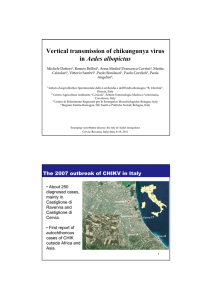
![Yellow-Fever_SA_2012-Ox_CNV [Converted]](http://s1.studylibit.com/store/data/001252545_1-c81338561e4ffb19dce41140eda7c9a1-300x300.png)
